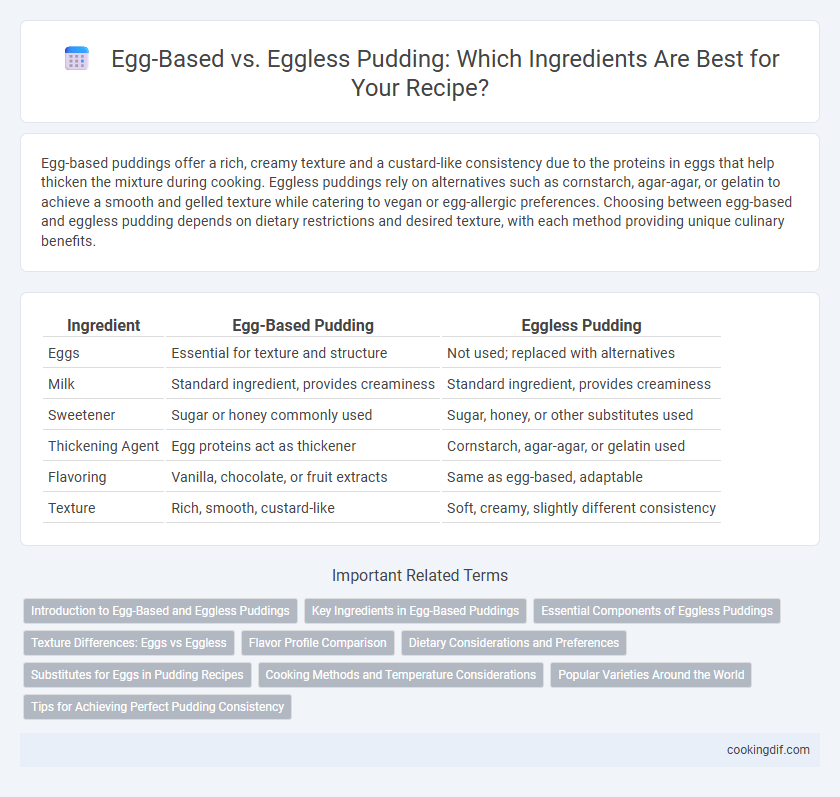Egg-based puddings offer a rich, creamy texture and a custard-like consistency due to the proteins in eggs that help thicken the mixture during cooking. Eggless puddings rely on alternatives such as cornstarch, agar-agar, or gelatin to achieve a smooth and gelled texture while catering to vegan or egg-allergic preferences. Choosing between egg-based and eggless pudding depends on dietary restrictions and desired texture, with each method providing unique culinary benefits.
Table of Comparison
| Ingredient | Egg-Based Pudding | Eggless Pudding |
|---|---|---|
| Eggs | Essential for texture and structure | Not used; replaced with alternatives |
| Milk | Standard ingredient, provides creaminess | Standard ingredient, provides creaminess |
| Sweetener | Sugar or honey commonly used | Sugar, honey, or other substitutes used |
| Thickening Agent | Egg proteins act as thickener | Cornstarch, agar-agar, or gelatin used |
| Flavoring | Vanilla, chocolate, or fruit extracts | Same as egg-based, adaptable |
| Texture | Rich, smooth, custard-like | Soft, creamy, slightly different consistency |
Introduction to Egg-Based and Eggless Puddings
Egg-based puddings rely on eggs as a key ingredient, providing rich texture and natural thickening properties essential for classic recipes like custards and flans. Eggless puddings use alternatives such as cornstarch, agar-agar, or gelatin to achieve a creamy consistency while catering to dietary restrictions and vegan preferences. Both types offer diverse flavor profiles and nutritional benefits, with egg-based versions typically higher in protein and eggless options suitable for allergy-sensitive or plant-based diets.
Key Ingredients in Egg-Based Puddings
Egg-based puddings rely on key ingredients such as whole eggs or egg yolks to create a rich, creamy texture and provide structure through protein coagulation during cooking. Milk or cream complements the eggs, while sugar adds sweetness and often vanilla or other flavorings enhance taste complexity. The presence of eggs distinguishes these puddings by lending firmness and a smooth, custard-like consistency that eggless alternatives typically lack.
Essential Components of Eggless Puddings
Eggless puddings rely on essential components such as plant-based thickeners like cornstarch, agar-agar, or tapioca starch to achieve the creamy texture typically provided by eggs. Alternative binding agents including silken tofu, mashed bananas, or pureed fruits contribute moisture and structure without altering flavor. These ingredients ensure the pudding maintains its smooth consistency while catering to vegan and allergy-sensitive diets.
Texture Differences: Eggs vs Eggless
Egg-based puddings offer a rich, creamy texture with a custard-like consistency due to the coagulation of egg proteins during cooking. Eggless puddings, often thickened with starches like cornstarch or agar, have a smoother, silkier mouthfeel but lack the firm structure eggs provide. The choice between egg and eggless recipes significantly influences the final pudding's density and creaminess, catering to dietary preferences or allergen considerations.
Flavor Profile Comparison
Egg-based pudding offers a rich, creamy texture with a custard-like flavor that enhances its smoothness and depth, thanks to the natural emulsifying properties of eggs. Eggless pudding tends to have a lighter texture and more subtle taste, often relying on alternatives like cornstarch or agar-agar to achieve similar thickness without the distinct eggy richness. The choice between egg-based and eggless versions significantly impacts the overall flavor profile, with egg-based pudding delivering a more indulgent and traditional taste experience.
Dietary Considerations and Preferences
Egg-based puddings offer rich texture and protein but may pose allergen risks for individuals with egg allergies or dietary restrictions such as veganism. Eggless puddings typically use alternatives like cornstarch, agar-agar, or plant-based milk, catering to lactose intolerant, vegan, and allergy-sensitive consumers. Choosing between egg-based and eggless pudding depends largely on dietary needs, ethical preferences, and potential allergen avoidance.
Substitutes for Eggs in Pudding Recipes
Egg-based puddings rely on eggs as a key ingredient for structure, richness, and creamy texture, while eggless puddings use substitutes such as cornstarch, agar-agar, or silken tofu to achieve similar consistency and smoothness. Cornstarch acts as a thickening agent that mimics the custard-like texture of egg puddings without altering flavor. Agar-agar, derived from seaweed, is a vegan alternative that provides firmness, and silken tofu adds protein and a creamy mouthfeel, making these options ideal for egg-free or dairy-free pudding recipes.
Cooking Methods and Temperature Considerations
Egg-based puddings require gentle, low-temperature cooking methods such as steaming or baking in a water bath to prevent curdling and achieve a smooth, custard-like texture. Eggless puddings rely on thickening agents like cornstarch or agar, allowing for higher temperatures during stovetop cooking or chilling without risk of coagulation. Precise temperature control is crucial in egg-based puddings, typically between 160degF to 180degF, while eggless varieties offer more flexibility with heat exposure.
Popular Varieties Around the World
Egg-based puddings, such as traditional British custard and French creme brulee, rely on eggs for a rich, creamy texture and a smooth, velvety consistency. Eggless puddings like Indian rice pudding (kheer) and Filipino maja blanca use alternative thickeners such as coconut milk, rice, or cornstarch, catering to vegan preferences and avoiding allergens. Each variety reflects regional ingredients and cultural tastes, making egg-based and eggless puddings popular choices worldwide.
Tips for Achieving Perfect Pudding Consistency
For perfect pudding consistency, egg-based recipes require careful tempering of eggs to avoid curdling and ensure a smooth, creamy texture. Eggless puddings rely on cornstarch or agar-agar as thickening agents, requiring precise heat control to prevent lumps and achieve an ideal set. Maintaining low to medium heat and constant stirring are crucial techniques across both methods to attain a velvety, uniform pudding.
Egg-based vs Eggless for ingredients Infographic

 cookingdif.com
cookingdif.com